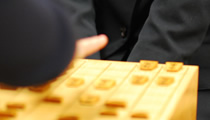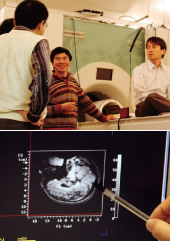 Professional Shogi ( Japanese Chess ) players have built up their intuitive thinking and determine the next move in the game intuitively and instantaneously from their rich experience. Understanding the intuitive thinking mechanism of human being by elucidating the neural information network in Shogi game through detailed analysis of how Shogi players judge the current situation and determine the next move, could lead to the key to understand the mechanisms of thinking part of human brain.
Professional Shogi ( Japanese Chess ) players have built up their intuitive thinking and determine the next move in the game intuitively and instantaneously from their rich experience. Understanding the intuitive thinking mechanism of human being by elucidating the neural information network in Shogi game through detailed analysis of how Shogi players judge the current situation and determine the next move, could lead to the key to understand the mechanisms of thinking part of human brain.
Great challenges on intuitive thinking of human to approach from brain science is in finding ways to precisely measure brain activity during they are thinking intuitively. A number of difficulties are involved:
- A considerable number of groups of subjects with deep knowledge of a particular topic must be brought together, as well as an associated control group.
- Subjects must be induced to think, and to think continuously.
- Measurement data must be accompanied by an explanation of what subjects were thinking about, in a form that allows for third-party verification of results.
As a group with powerful thought capabilities, among them a high degree of intuition, professional Shogi players constitute a very suitable match for the above three requirements, and:
- There exist groups of Shogi players recognized as professionals who have studied the game from a very young age. There are also various levels of amateur players in Japan who could be subjects for experiments as a control group.
- Shogi players can play the game not physically moving a piece, but simply imaging the Shogi board in their mind.
- Shogi players can focus their attention continuously on a single target such as the shogi match or the shogi mating problem.
- Shogi players can explain what moves they were thinking about following actual measurement, which can be verified by other professional shogi players.
With cooperation from the Japan Shogi Association and professional Shogi players as subjects for experiments, RIKEN Brain Science Institute, Fujitsu and Fujitsu Laboratories have launched a joint research project titled "Exploratory Research on Shogi Brain Activity" in order to understand the intuitive thinking mechanism of human beings by elucidating the neural information processing network in the Shogi game through detailed analysis of how Shogi players judge the current situation and determine the next move.

The following three lines of research are currently being pursued:

- fMRI brain scans are taken of professional Shogi players while they are figuring out the moves of pieces in their brains, and these scans are used to study locations of brain activity.

- The brainwaves of professional Shogi players are recorded while they are figuring out the moves of pieces in their brains, and these are used to study the relationship between brainwaves and the timing of brain activity.

- Studying learning processes involving cooperation between the cerebrum and the cerebellum by psychological experiments and fMRI.
More specifically, we try to understand the processes of intuitive thinking of Shogi players from the point of view of brain science by comparing brain activity of groups of professionals and amateurs, involved in their recognition and memory of shogi board configurations and solving the Shogi mating problems and endgame, measured by the electroencephalogram and fMRI .
Existing studies have indicated the different thinking patterns in the professional Shogi player’s brain from those of the amateurs when they figure out board configurations and determine the next moves instantaneously. It has also become clear that there is a difference between professionals and amateurs in the size of the region of the cerebellum that is active during such processes. We can use this information for improving our understanding of intuitive thinking processes.
Elucidating intuitive thought in Shogi would be a breakthrough to understand how the brain is shaped and developed by culture, to understand intelligence. It also promises broad advancements in the development of information technologies that apply this mechanism to training on knowledge about how highly-skilled technicians pass down their skills and on the stable operation of complex information systems. Future connections with artificial intelligence and with the development of new human-like computers are also envisioned.
